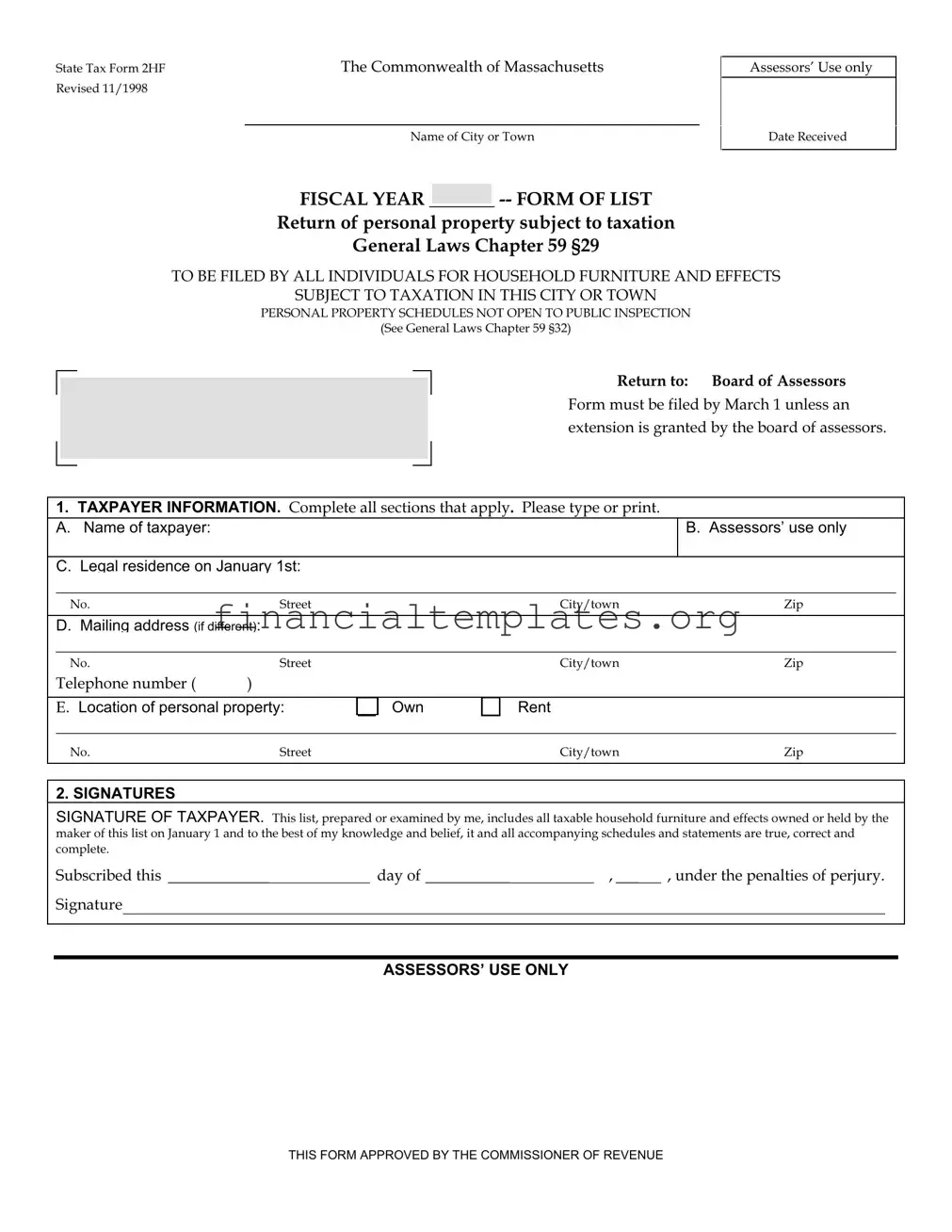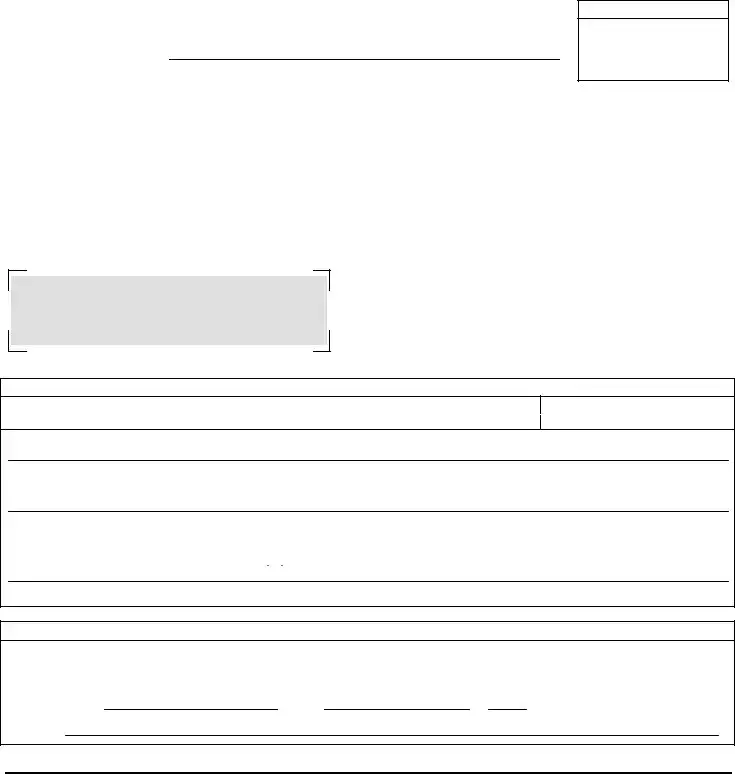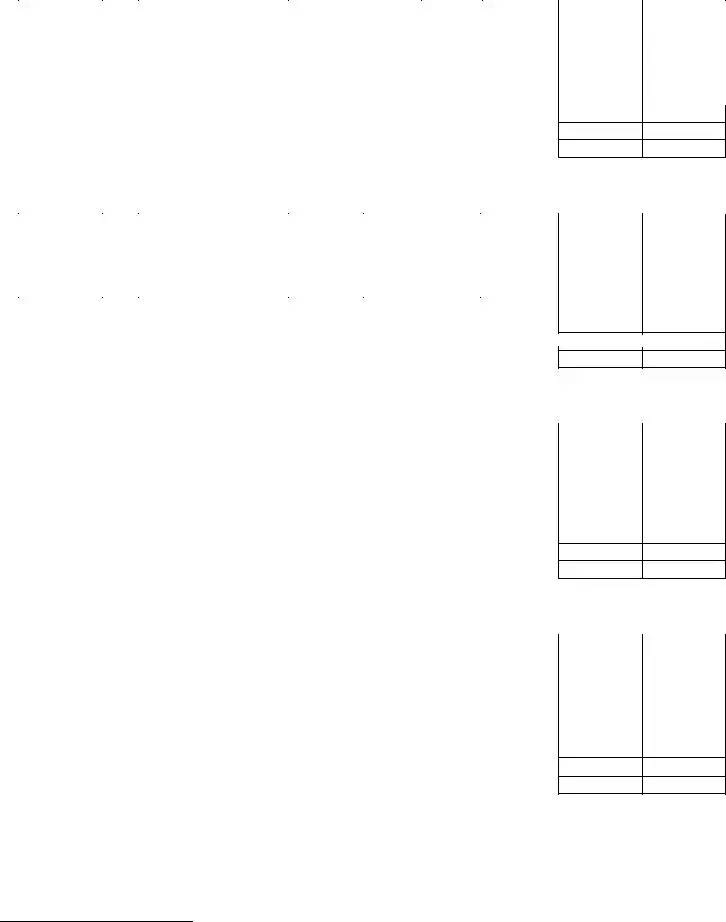State Tax Form 2HF |
The Commonwealth of Massachusetts |
Revised 11/1998 |
|
Name of City or Town
Assessors’ Use only
Date Received
FISCAL YEAR _______ -- FORM OF LIST
Return of personal property subject to taxation
General Laws Chapter 59 §29
TO BE FILED BY ALL INDIVIDUALS FOR HOUSEHOLD FURNITURE AND EFFECTS
SUBJECT TO TAXATION IN THIS CITY OR TOWN
PERSONAL PROPERTY SCHEDULES NOT OPEN TO PUBLIC INSPECTION
(See General Laws Chapter 59 §32)
Return to: Board of Assessors
Form must be filed by March 1 unless an extension is granted by the board of assessors.
1.TAXPAYER INFORMATION. Complete all sections that apply. Please type or print.
A.Name of taxpayer: 
 B. Assessors’ use only C. Legal residence on January 1st:
B. Assessors’ use only C. Legal residence on January 1st:
|
No. |
|
|
Street |
|
|
|
|
City/town |
|
Zip |
|
|
|
|
|
|
|
|
|
|
|
|
|
|
|
|
|
|
|
|
D. Mailing address (if different): |
|
|
|
|
|
|
|
|
|
|
|
|
|
|
|
|
|
|
|
|
|
|
|
|
|
|
|
|
|
|
|
|
|
|
|
|
|
|
|
|
|
|
|
|
|
|
|
|
|
|
|
|
No. |
|
|
Street |
|
|
|
|
City/town |
|
Zip |
|
Telephone number ( |
|
|
|
|
|
|
|
|
|
|
|
|
|
|
|
) |
|
|
|
|
|
|
|
|
|
|
|
|
|
|
|
|
|
|
|
|
|
|
|
|
|
|
|
|
|
|
|
|
|
|
|
|
|
|
|
|
|
|
|
|
|
|
|
E. Location of personal property: |
|
Own |
|
|
Rent |
|
|
|
|
|
|
|
|
|
|
|
|
|
|
|
|
|
|
|
|
|
No. |
|
|
Street |
|
|
|
|
City/town |
|
Zip |
2. SIGNATURES
SIGNATURE OF TAXPAYER. This list, prepared or examined by me, includes all taxable household furniture and effects owned or held by the maker of this list on January 1 and to the best of my knowledge and belief, it and all accompanying schedules and statements are true, correct and complete.
Subscribed this
Signature
day of |
|
, |
|
, under the penalties of perjury. |
|
|
|
|
THIS FORM APPROVED BY THE COMMISSIONER OF REVENUE
3. GENERAL INFORMATION
A.WHO MUST FILE A RETURN. This Form of List (State Tax Form 2HF) must be filed each year by all individuals owning or holding household furnishings and effects not located at their domicile on January 1. Individuals who own or hold other taxable property must also file State Tax Form 2. Literary, temperance, benevolent, charitable or scientific organizations that may be entitled to an exemption under G.L. Ch. 59 §5 Clause 3 must file State Tax Form 3ABC listing all property they own or hold for those purposes on January 1.
B.WHEN AND WHERE RETURN MUST BE FILED. Returns must be filed by March 1 with the board of assessors in the city or town where the household furnishings and effects are situated on January 1. A return is not considered filed unless it is complete.
C.EXTENSION OF FILING DEADLINE. The board of assessors may extend the filing deadline if you can show sufficient reason for not filing on time. The latest date the filing deadline can be extended is 30 days after the tax bills are mailed for the fiscal year. Requests for an extension must be made in writing to the assessors.
D.PENALTY FOR FAILURE TO FILE OR FILING LATE. If you do not file a return for the fiscal year, the assessors cannot grant an abatement for overvaluation of the personal property for that year. If the return is not filed on time, the assessors can only grant an abatement if you show a reasonable excuse for the late filing or the tax assessed is more than 150% of the amount that would have been assessed if the return had been timely filed. In that case, only the amount over that percentage can be abated. You can avoid this penalty by filing on time.
E.USE OF AND ACCESS TO RETURN. The information in the return is used by the board of assessors to determine the taxable or exempt status of your personal property and, if taxable, its fair market value. You may also be required to provide the assessors with further information about the property in writing and asked to permit them to inspect it.
Personal property information listed in Schedules A-F is not available to the public for inspection under the state public records law. It is available only to the assessors and Massachusetts Department of Revenue for the purpose of administering the tax laws.
4. INSTRUCTIONS FOR COMPLETING SCHEDULES
List all household items, furnishings and effects owned or held on January 1 in the appropriate schedules that follow, including those in your physical possession on that date under a lease, consignment, license, mortgage, pledge or other arrangement. For your return to be considered complete, all information specified in the schedules except the “Estimated Market Value” must be provided and all copies of leases, consignments, etc., for any property in your possession under such arrangements must be attached.
A.APPLIANCES AND SMALL ELECTRONICS. Includes all major appliances (refrigerators, freezers, washing machines), small appliances (microwave ovens, vacuum cleaners, coffee makers, blenders, food processors) and electronics (radios, stereos, televisions, video cassette recorders).
B.TOOLS AND EQUIPMENT. Includes all household tools and equipment (lawnmowers, etc.) not listed as appliances and small electronics.
C.FURNITURE AND ACCESSORIES. Includes all household furniture (desks, chairs, tables, couches, beds), lamps, rugs, floor coverings and draperies, specialized lease-hold improvements (modular walls, etc.), works of art and decorations, books and libraries and all other furnishings and accessories.
D.PERSONAL EFFECTS. Includes all jewelry, china, glassware, linens, bedding and all other personal effects.
E.UNREGISTERED MOTOR VEHICLES AND TRAILERS. Includes motor vehicles not carrying Massachusetts registration plates under G.L. Ch. 90, and tractors, trailers, snowmobiles, motorized golf carts and all other kinds and types of unregistered vehicles.
F.OTHER TAXABLE PERSONAL PROPERTY. Includes all other household furniture and effects not located at your domicile that are not specifically exempt from taxation.
A. APPLIANCES AND SMALL ELECTRONICS |
|
|
|
|
|
|
* Own/Other |
No. |
Description |
Manufacturer |
Model |
Year of |
Purchase |
Estimated |
|
|
|
|
|
|
purchase |
price |
market value |
|
|
|
|
|
|
|
|
|
|
|
|
|
|
|
|
|
|
|
|
|
|
|
|
|
|
|
|
|
|
|
|
|
|
|
|
|
|
|
|
|
|
|
|
|
Continue list on attachment, in same format, as necessary. |
Subtotal Schedule A |
|
Subtotal attachment |
|
TOTAL |
B. TOOLS AND EQUIPMENT |
|
|
|
|
|
|
*Own/Other |
No. |
Description |
Nature of |
Type/model |
Year of |
Purchase |
Estimated |
|
|
|
|
use |
|
purchase |
price |
market value |
|
|
|
|
|
|
|
|
|
|
|
|
|
|
|
|
|
|
|
|
|
|
|
|
|
|
|
|
|
|
|
|
|
|
|
|
Continue list on attachment, in same format, as necessary. |
Subtotal Schedule B |
|
Subtotal attachment |
|
TOTAL |
C. FURNITURE AND ACCESSORIES
*Own/Other |
No. |
Description |
Year of |
Purchase |
Estimated |
|
|
|
purchase |
price |
market value |
|
|
|
|
|
|
|
|
|
|
|
|
|
|
|
|
|
|
|
|
|
|
|
|
Continue list on attachment, in same format, as necessary. |
Subtotal Schedule C |
|
Subtotal attachment |
|
TOTAL |
D. PERSONAL EFFECTS
*Own/Other |
No. |
Description |
Year of |
Purchase |
Estimated |
|
|
|
purchase |
price |
market value |
|
|
|
|
|
|
|
|
|
|
|
|
|
|
|
|
|
|
|
|
|
|
|
|
Continue list on attachment, in same format, as necessary. |
Subtotal Schedule D |
|
Subtotal attachment |
|
TOTAL |
*Specify if property owned, leased, consigned, etc. and attach copies of lease or other agreement with owner.
E. UNREGISTERED MOTOR VEHICLES AND TRAILERS
*Own/Other |
Year |
Model, |
Make |
Type: Describe sufficiently for identification |
No. of |
Purchase |
Estimated |
|
of |
name, |
|
giving number of passengers, number of |
cylinders |
price |
market value |
|
mfr. |
letter or |
|
doors, type of body. If not required to be |
or rated |
|
|
|
|
number |
|
registered, so state and name use. |
capacity |
|
|
|
|
|
|
|
|
|
|
|
|
|
|
|
|
|
|
|
|
|
|
|
|
|
|
|
|
|
|
|
|
|
|
Continue list on attachment, in same format, as necessary. |
Subtotal Schedule E |
|
Subtotal attachment |
|
TOTAL |
F. OTHER TAXABLE PERSONAL PROPERTY |
|
|
|
|
*Own/Other |
No. |
Description |
Year of |
Purchase |
Estimated |
|
|
|
|
purchase |
price |
market value |
|
|
|
|
|
|
|
|
|
|
|
|
|
|
|
|
|
|
|
|
|
|
|
|
|
|
|
|
Continue list on attachment, in same format, as necessary. |
Subtotal Schedule F |
|
Subtotal attachment |
|
TOTAL |



 B. Assessors’ use only C. Legal residence on January 1st:
B. Assessors’ use only C. Legal residence on January 1st:

